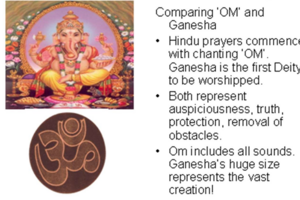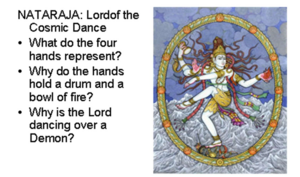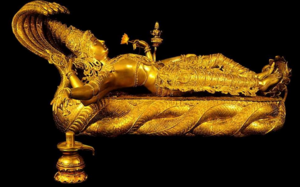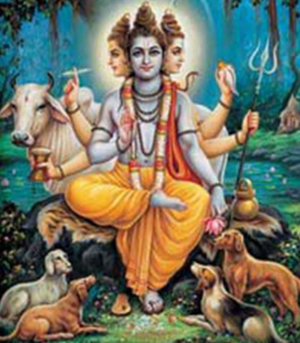Talk:The Symbolism of the Forms of Īshvara & Devas
By Sri Vishal Agarwal
The various forms of bhagavān in Hindu tradition are not merely anthropomorphic depictions but carry profound symbolic meaning. Several examples illustrate this symbolic dimension:
Gaṇeśa as the Symbol of Om' Gaṇeśa is interpreted as the visible symbol of Om turned clockwise by ninety degrees. His two tusks represent ātman and māyā (delusion or ignorance). By breaking the tusk of māyā, Gaṇeśa embodies the pure ātman. For this reason, prayers traditionally begin with the utterance of Om and with an invocation to Gaṇeśa as the first deva.
Śiva as Naṭarāja In the form of Naṭarāja, Śiva is encircled by a ring of flames symbolizing creation itself. The bowl of fire denotes destruction, while the ḍamarū drum represents the primordial sound of creation. The demon under his feet personifies evil and ignorance. Śiva’s gesture towards the demon emphasizes the necessity of subduing ignorance, while his raised hand assures protection and grace. Collectively, the circle, fire, and drum signify the cycle of rebirth, with liberation (mokṣa) attainable through wisdom and divine blessing.
Padmanābhasvāmy – Viṣṇu with Brahmā Emerging from the Navel At the Anantapadmanābhasvāmy shrine in Thiruvananthapuram (Kerala), Viṣṇu is depicted reclining on Śeṣanāga. From his navel extends an umbilical cord culminating in a lotus on which Brahmā, the creator, is seated. This reverses the human analogy—here, the creator emerges from the navel of the preserver.
In the same icon, Viṣṇu is shown offering flowers to a Śivaliṅga placed below him, signifying reverence toward Śiva. The image thus conveys the interconnection of Brahmā, Viṣṇu, and Śiva as complementary manifestations of the same ultimate reality.
Dattātreya Dattātreya is revered as the son of Sage Atri (“one free of the three,” i.e., the three guṇas of prakṛti) and Anasūyā (“one free of hatred or jealousy”). Their union represents the conditions necessary for spiritual realization of brahman.
Dattātreya’s three heads symbolize the essence of Brahmā, Viṣṇu, and Śiva. His six arms bear the insignia of these deities. He is accompanied by four dogs, representing the four Vedas, and a cow, symbolizing spiritual wisdom and nourishment. The imagery suggests that realization transcends even scriptural study, with wisdom as the true sustenance of spiritual life.
The Dattātreya Upaniṣad begins by identifying him with Viṣṇu and concludes by presenting him as an incarnation (avatāra) of Śiva. Accordingly, his worship is found within both Śaiva and Vaiṣṇava traditions.




